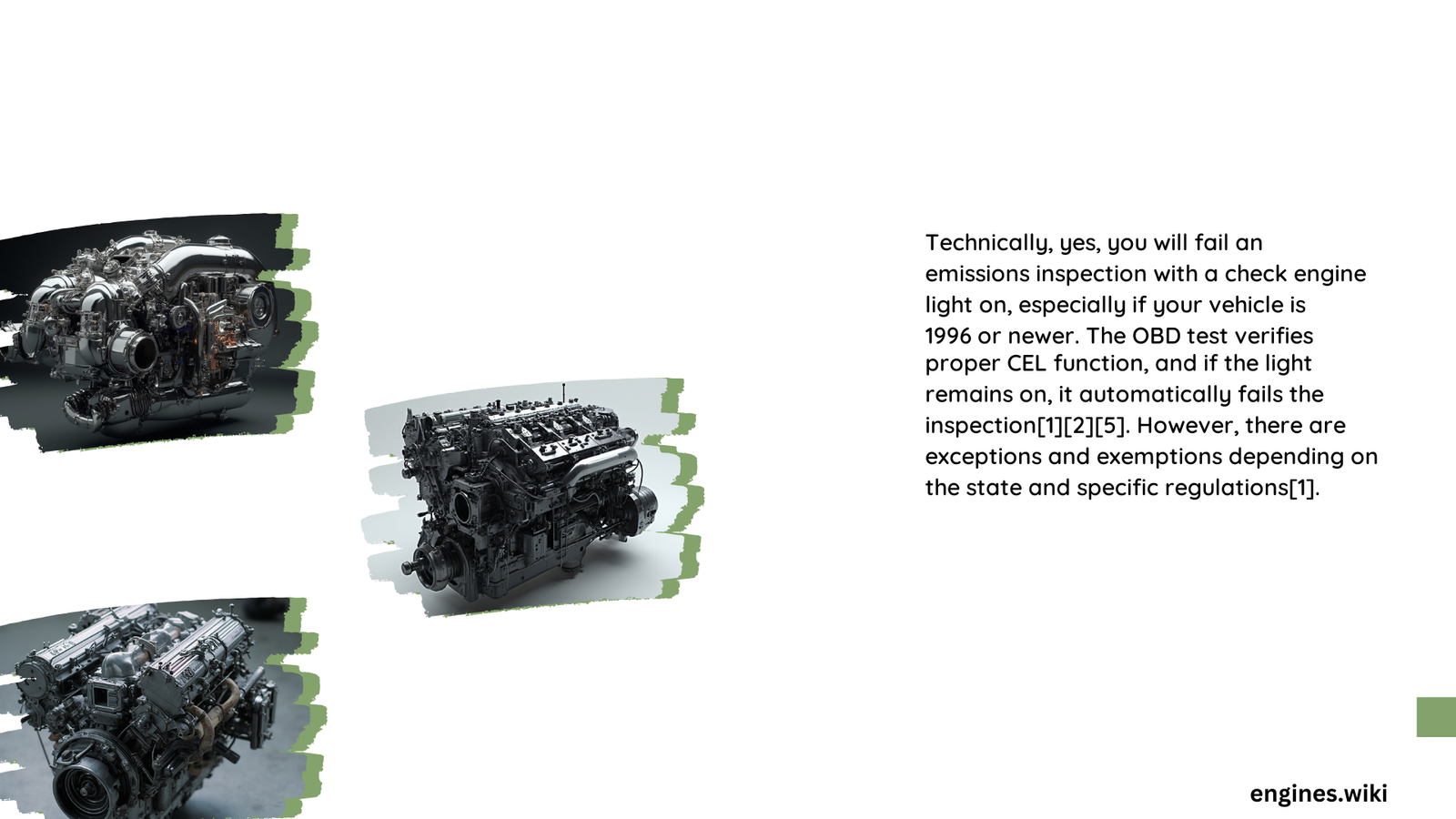A vehicle with an illuminated check engine light will typically fail an inspection. Most states require the check engine light to be off for a vehicle to pass. The light indicates potential emissions or safety issues that must be addressed before passing inspection. However, specific regulations vary by state, and some may allow limited exceptions or grace periods for certain non-emissions related codes.
What Are the State Regulations Regarding Failing a Vehicle Inspection Due to a Check Engine Light?
State regulations on vehicle inspections and check engine lights vary, but generally follow these guidelines:
-
Emissions Inspections: Most states automatically fail vehicles with an illuminated check engine light during emissions testing. This is because the light indicates a problem with the vehicle’s emissions control system.
-
Safety Inspections: Some states separate safety and emissions inspections. In these cases, a check engine light may not automatically fail a safety inspection, but it could still indicate issues that would cause a failure.
-
OBD-II System Checks: For vehicles manufactured after 1996, the On-Board Diagnostic (OBD-II) system is typically checked as part of the inspection. An illuminated check engine light often means the OBD-II system has detected a problem, leading to a failed inspection.
-
Specific Code Exceptions: A few states may allow vehicles to pass inspection with certain non-emissions related diagnostic trouble codes (DTCs), but this is not common.
Here’s a table summarizing the general approach in different regions:
| Region | Typical Approach to Check Engine Light |
|---|---|
| Northeast | Strict – Usually automatic failure |
| West Coast | Strict – Typically automatic failure |
| Midwest | Varies by state – Often automatic failure |
| South | Some states more lenient, others strict |
How Does the Check Engine Light Impact Vehicle Emissions Tests?

The check engine light significantly impacts emissions tests in the following ways:
-
Automatic Failure: In most states, an illuminated check engine light results in an automatic failure of the emissions test.
-
Indicates Emissions Issues: The light often signifies problems with components crucial to emissions control, such as:
- Oxygen sensors
- Catalytic converter
- Evaporative emissions system
-
Fuel injection system
-
OBD-II System Check: The emissions test typically includes a check of the OBD-II system. An illuminated check engine light often means this system check will fail.
-
Prevents Accurate Testing: Even if the actual emissions are within acceptable limits, many testing facilities won’t proceed with the test if the check engine light is on, as it indicates potential inaccuracies in the results.
What Are the Steps to Diagnose and Resolve Check Engine Light Issues?
To address check engine light issues before an inspection:
- Read the Code:
- Use an OBD-II scanner to retrieve the diagnostic trouble code (DTC)
-
This can be done at most auto parts stores for free or with an inexpensive personal scanner
-
Research the Code:
- Look up the meaning of the specific DTC
-
Understand the potential causes and solutions
-
Inspect and Test:
- Perform a visual inspection of related components
-
Conduct further diagnostic tests as needed
-
Repair or Replace:
-
Address the underlying issue, which may involve:
- Replacing faulty sensors
- Repairing wiring
- Fixing leaks
- Replacing larger components like the catalytic converter
-
Clear the Code:
- After repairs, clear the code using the OBD-II scanner
-
Drive the vehicle to ensure the light doesn’t come back on
-
Re-check:
- If the light returns, repeat the process or seek professional help
What Are the Consequences of Ignoring a Check Engine Light?
Ignoring an illuminated check engine light can lead to several negative outcomes:
-
Failed Inspections: You will likely fail emissions and safety inspections in most states.
-
Legal Issues:
- Potential fines for driving with emissions problems
-
Risk of being pulled over in areas where visible check engine lights are a violation
-
Increased Repair Costs:
- Minor issues can escalate into major problems if left unaddressed
-
Example: A faulty oxygen sensor can lead to catalytic converter failure, increasing repair costs from about $200 to over $1000
-
Reduced Fuel Efficiency: Many check engine light issues result in decreased fuel economy, costing more at the pump.
-
Vehicle Performance Issues:
- Engine misfires
- Reduced power
-
Rough idling
-
Environmental Impact: Unresolved emissions issues contribute to increased pollution.
-
Decreased Vehicle Value: A persistent check engine light can lower the resale or trade-in value of your vehicle.
Remember, the check engine light is a crucial warning system designed to protect your vehicle and the environment. Addressing issues promptly can save money, time, and potential headaches in the long run.
